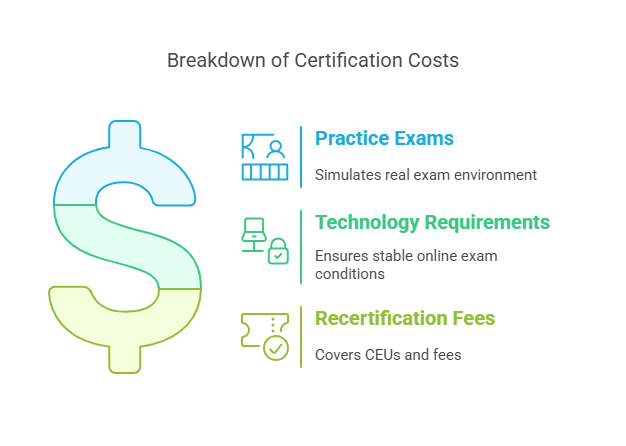Understanding the ICD-10 Certification Cost: A Detailed Guide
Understanding the cost of ICD-10 certification is crucial for anyone interested in pursuing a career in medical coding or billing. This guide provides an in-depth look at the various costs associated with obtaining the ICD-10 certification, including exam fees, study materials, online courses, and other necessary expenses. Planning for these costs in advance will help you manage your budget and avoid unexpected financial burdens as you work toward your certification.
What is ICD-10 Certification and Its Benefits?
ICD-10 certification is a professional credential that verifies an individual's expertise in the International Classification of Diseases, 10th Revision (ICD-10) coding system. This certification, along with medical billing and coding certification from AMBCI, is essential for medical coders, billers, and healthcare professionals who need to stay updated on the latest coding standards and guidelines. It ensures that healthcare providers receive appropriate reimbursement for their services and that patient records are accurately documented.
The ICD-10 certification helps professionals in the healthcare sector demonstrate their competency in assigning ICD-10 codes for medical billing, making it a valuable asset for career advancement. With the healthcare industry growing rapidly, ICD-10-certified coders are in high demand, offering better job prospects and higher earning potential.
Cost Breakdown for ICD-10 Certification
The cost of obtaining ICD-10 certification can be broken down into several key components: exam fees, study materials, and online courses. Understanding these costs upfront will allow you to budget more effectively and prepare thoroughly for the exam.
Exam Fees
The certification exam fee is one of the most significant expenses. The registration costs for the ICD-10 certification exam are as follows:
Student Registration: $375 for one attempt, $475 for two attempts.
Core Exams: $399 for one attempt, $499 for two attempts.
Specialty Exams: $299 for one attempt, $399 for two attempts.
For those who are AAPC members, discounts are often available, reducing the cost of registration. It’s important to note that the certification exam can be taken multiple times if necessary, but additional fees may apply.
Study Materials and Textbooks
To prepare for the ICD-10 certification exam, you will need a variety of study materials and textbooks. The cost of these resources varies depending on the courses you choose and the textbooks you select. The ICD-10-CM Coding Manual is an essential resource, and using the most current edition ensures you are aligned with updated coding standards.
High-quality study materials can be a significant expense but are crucial to passing the exam. These resources include textbooks, practice coding exercises, and online resources that cover key areas such as anatomy and physiology.
Online Courses and Training Programs
Online courses are an effective way to prepare for ICD-10 certification. For example, Coding Clarified offers a comprehensive medical coding program that includes textbooks and other materials for an immersive learning experience. Some online courses can cost around $4,999 if paid upfront, and additional costs may include $25 for each individual course module.
For online learning, you will need consistent internet access and the necessary technology, such as a computer and webcam, to participate in remote classes and exams.
Additional Expenses
In addition to the exam and study materials, several other costs must be considered:
Practice Exams: Practice exams simulate the real exam environment and help you assess your readiness. AAPC members can access practice exams for $79.95.
Technology Requirements: A stable internet connection (at least 5 Mbps) is essential for online exams and courses. You will also need a secure browser for proctored exams to prevent cheating during the test.
Recertification Fees: To maintain your certification, you will need to complete Continuing Education Units (CEUs) and pay recertification fees. These costs vary depending on the certification body.
Financial Assistance and Payment Plans
There are several ways to reduce the financial burden of ICD-10 certification. Scholarships and grants, as well as employer sponsorship programs, are available to assist with the cost. Many educational institutions and certification bodies offer flexible payment plans, allowing you to spread the costs over time.
The Value of ICD-10 Certification
ICD-10 certification is an investment in your career. It opens up better job opportunities, increases earning potential, and provides professional recognition in the healthcare industry. With a growing demand for medical coders, having ICD-10 certification can set you apart from other candidates.
Increased Job Opportunities and Higher Earning Potential
The demand for certified medical coders is expected to grow significantly, with a projected 9% increase in employment opportunities from 2023 to 2033. This growth is due to the expanding healthcare sector and the need for accurate coding for medical billing and reimbursement.
Certified medical coders can earn an average annual salary of around $62,160, with the potential for higher earnings as they acquire additional certifications or specialize in specific areas of coding.
Summary
ICD-10 certification offers numerous benefits, including career advancement, increased earning potential, and professional recognition. While the costs can be substantial, careful planning and budgeting can help you manage expenses effectively. By considering all costs, from exam fees to study materials and practice exams, you can ensure you are financially prepared for the certification process.
Six Lesser-Known Facts About ICD-10 Certification
The transition from ICD-9 to ICD-10 codes led to significant improvements in coding accuracy and detail, allowing healthcare providers to report patient diagnoses more precisely. Learn more about the ICD-9 to ICD-10 transition
ICD-10 coders are in high demand due to the global increase in health services and the need for accurate medical records, offering a competitive edge for certified professionals. Explore more about ICD-10 coder demand
While the U.S. adopted ICD-10 in 2015, many other countries were already using ICD-10 for years before this change. See ICD-10 adoption worldwide
ICD-10 codes are used not only for medical billing but also in public health reporting and research, making coders an essential part of the healthcare system. Read more about the uses of ICD-10
Maintaining ICD-10 certification often requires completing a specific number of Continuing Education Units (CEUs) every two years, which ensures that professionals stay up-to-date with the latest coding practices. Understand the requirements for ICD-10 certification
Some employers may cover the cost of ICD-10 certification as part of employee development programs, particularly for positions related to medical coding and billing. Find out more about certification programs and employer support
Frequently Asked Questions
-
The costs typically include exam fees, study materials, online courses, practice exams, and technology requirements for online exams. There are also costs for maintaining certification through CEUs.
-
Yes, AAPC members receive discounts on registration fees, making the certification more affordable.
-
Yes, financial assistance is available through scholarships, grants, employer sponsorships, and flexible payment plans.
-
ICD-10 certification enhances your job prospects, increases earning potential, and provides professional recognition, making you more attractive to employers in the healthcare sector.
-
Ongoing costs include recertification fees and the completion of CEUs to stay updated with the latest coding standards.




